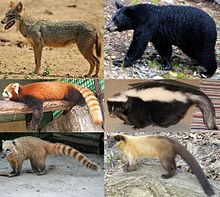Caniforms
| Caniforms Temporal range: 42–0 Ma Eocene-Holocene |
|
|---|---|
 |
|
| All extant land-dwelling caniform families (clockwise from top left): Canidae, Ursidae, Mephitidae, Mustelidae, Procyonidae, Ailuridae | |
| Scientific classification | |
| Kingdom: | Animalia |
| Phylum: | Chordata |
| Class: | Mammalia |
| Order: | Carnivora |
| Suborder: |
Caniformia Kretzoi, 1943 |
| Families | |
|
Amphicyonidae† ("bear-dogs") |
|
Amphicyonidae† ("bear-dogs")
Canidae (wolves, foxes)
Hemicyonidae† ("dog-bears")
Ursidae (bears)
Ailuridae (red pandas)
Enaliarctidae† (extinct pinnipeds)
Odobenidae (walrus)
Otariidae (sea lions)
Phocidae (true seals)
Mephitidae (skunks)
Mustelidae (weasels, wolverines)
Procyonidae (raccoons, kinkajous)
Caniformia, or Canoidea (literally "dog-like"), is a suborder within the order Carnivora. They typically possess a long snout and nonretractile claws (in contrast to the cat-like carnivorans, the Feliformia). The Pinnipedia (seals, walruses and sea lions) are also assigned to this group. The center of diversification for Caniformia is North America and northern Eurasia. This contrasts with the feliforms, the center of diversification of which was in Africa and southern Asia.
Most members of this group have nonretractile claws (the fisher,marten,red panda, and ringtail have retractile or semiretractile claws) and tend to be plantigrade (with the exception of the Canidae). Other traits that separate Caniformia from Feliformia is that caniforms have longer jaws and have more teeth, with less specialized carnassial teeth. They also tend more towards omnivory and opportunistic feeding, while the feliforms are more specialized for eating meat. Caniforms have single-chambered or partially divided auditory bullae, composed of a single bone, while in feliforms, the auditory bullae are double-chambered, composed of two bones joined by a septum.
...
Wikipedia
